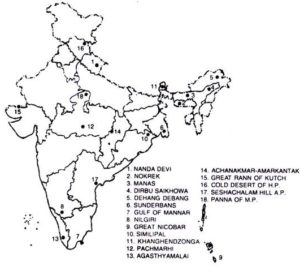Biosphere Reserves in India
Biosphere Reserves (BRs) are representative parts of natural and cultural landscapes extending over large area of terrestrial or coastal/marine ecosystems or a combination thereof and representative examples of bio-geographic zones/provinces.
Click here for strategy for UPSC: https://pscprep.com/strategy-for-upsc/
Criteria for designation of Biosphere Reserves
- A site that must contain an effectively protected and minimally disturbed core area of value of nature conservation.
- The core area should be typical of a bio-geographical unit and large enough to sustain viable populations representing all trophic levels in the ecosystem.
- The management authority to ensure the involvement/cooperation of local communities to bring variety of knowledge and experiences to link biodiversity conservation and socio-economic development while managing and containing the conflicts.
- Areas potential for preservation of traditional tribal or rural modes of living for harmonious use of environment.
International Status of Biosphere Reserves
The UNESCO has introduced the designation ‘Biosphere Reserve’ for natural areas to minimize conflict between development and conservation. BRs are nominated by national government which meet a minimal set of criteria and adhere to minimal set of conditions for inclusion in the world network of Biosphere reserves under the Man and Biosphere Reserve Programme of UNESCO. Globally 621 BRs representing from 117 countries included in the network so far.
Zones of Biosphere Reserves
Biosphere reserves are demarcated into following 3 inter-related zones:
Core Zone
Core zone must contain suitable habitat for numerous plant and animal species, including higher order predators and may contain centres of endemism. Core areas often conserve the wild relatives of economic species and also represent important genetic reservoirs having exceptional scientific interest. A core zone being National Park or Sanctuary/protected/regulated mostly under the Wildlife (Protection) Act, 1972. Whilst realizing that perturbation is an ingredient of ecosystem functioning, the core zone is to be kept free from l human pressures external to the system.
Buffer Zone
The buffer zone, adjoins or surrounds core zone, uses and activities are managed in this area in the ways that help in protection of core zone in its natural condition. These uses and activities include restoration, demonstration sites for enhancing value addition to the resources, limited recreation, tourism, fishing, grazing, etc; which are permitted to reduce its effect on core zone. Research and educational activities are to be encouraged. Human activities, if natural within BR, are likely to continue if these do not adversely affect the ecological diversity.
Transition Zone
The transition area is the outermost part of a biosphere reserve. This is usually not delimited one and is a zone of cooperation where conservation knowledge and management skills are applied and uses are managed in harmony with the purpose of the biosphere reserve. This includes settlements, crop lands, managed forests and area for intensive recreation and other economic uses characteristics of the region.
Functions of Biosphere Reserves
- To conserve the diversity and integrity of plants and animals within natural ecosystems
- To safeguard genetic diversity of species on which their continuing evolution depends
- To ensure sustainable use of natural resources through most appropriate technology for improvement of economic well-being of the local people
- To provide areas for multi-faceted research and monitoring
- To provide facilities for education and training
The activities permitted under the scheme are broadly under the following areas:
- Value addition activities
- Sustainable use of threatened resources
- Rehabilitation of landscapes of threatened species and ecosystems
- Socio-economic upliftment of local communities
- Maintenance and protection of corridor areas
- Development of communication system and Networking
- Development of Eco-tourism
There are 18 Biosphere Reserves in India. 10 of these are part of World Network of Biosphere Reserves based on the UNESCO Man and Biosphere Programme(MAB)

Biosphere reserves which are a part of MAB(10)
The other eight Biosphere Reserves are:
BIOSPHERE RESERVES STATEWISE(14 STATES 2 SPLIT BETWEEN MPCG AND KERALA/TN MAX MP & TN(4) )
- Nanda Devi-UK
- Cold Desert-HP
- Panchmarhi-MP
- Panna-MP
- Amarkantak-MPCG
- Great Rann of Kutch-Guj
- Sunderbans-WB
- Manas-Assam
- Dibru-Saikhowa-Assam
- Kangchenjunga-Sikkim
- Dihang Dibang-Arunanchal
- Nokrek-Meghalaya
- Simlipal-Orissa
- Seshachalam-AP
- Nilgiri-TN
- Gulf of Mannar-TN
- Agasthyamala-Kerala & TN
- Great Nicobar-A&N
UNESCO MAB website : http://www.unesco.org/new/en/natural-sciences/environment/ecological-sciences/biosphere-reserves/

To get the package fill the form below
The package consists of summaries of curated sources for studying the most critical subjects of UPSC in the most comprehensive manner. The summaries are prepared in consultation with exam toppers and serving/retired civil servants along with our own team of experts who ensure that you refer to the most relevant content in your preparation journey.
In the current exam scenario the bigger challenge is not the lack of material but the availability of excessive material that often confuses aspirants. Hence this package is our endeavor to minimize wastage and maximize utilization of an aspirants precious time. What will also be of interest to you is the fact that unlike many other institutions we have prepared the whole package in an editable format so that you can easily edit, append, delete the notes to suit your current preparation.
Quality of the notes is our most important focus. Coming from the house of PSCPREP you can be rest assured that the notes are of the topmost quality.